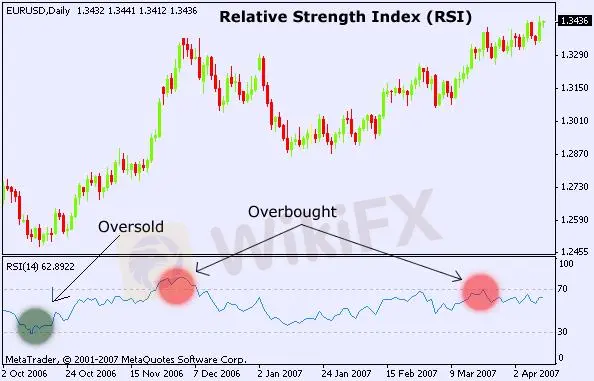简体中文
繁體中文
English
Pусский
日本語
ภาษาไทย
Tiếng Việt
Bahasa Indonesia
Español
हिन्दी
Filippiiniläinen
Français
Deutsch
Português
Türkçe
한국어
العربية
1 Minute Scalping Strategy: A Comprehensive Guide for Beginners
Abstract:Trading can be thrilling and sometimes complex. One popular method is 1 Minute Scalping. This approach is great for traders who enjoy quick action and instant results, capitalizing on small price changes in very short timeframes. In this guide, we will break down what the 1 Minute Scalping Strategy is, why it can be beneficial, and share some scalping indicators for you.

What is 1 Minute Scalping?
In the high stakes, swiftly shifting world of day trading, the term 'scalping' refers to a strategy where the trader aims to profit from small price changes. This strategy is based on the idea that small, almost negligible profits can accumulate to a substantial sum if executed consistently and accurately. Now, let's translate this concept into the '1 Minute Scalping' context.
1 Minute Scalping, as the name implies, concerns itself with time frames as minimal as one minute. In this intense and rapid strategy, a day trader will buy or sell a specific financial instrument with the intention of closing the position quickly, often within minutes or seconds, to gain small, frequent gains.
| Asset | Timeframe | Indicators | Sessions |
| Forex Pairs | 1 Minute | Moving Averages, Stochastic Oscillator, Bollinger Bands, Pivot Points, RSI, MACD | London/New York Overlap, London/Tokyo Overlap |
This strategy thrives on high liquidity and high volatility markets. Traders rely both on fundamental analysis, taking into account news events, economic indicators, etc., and technical analysis, using charts and other tools, to form a strategy. These decisions have to be made rapidly, given the constant fluctuation and short timeframe involved.
In the next sections, we will explore the inherent benefits and challenges that the 1 Minute Scalping Strategy presents and how to navigate the path to potentially profitable trades while minimizing risks.
Pros & Cons
In exploring the 1 Minute Scalping Strategy, we uncover a host of attractive benefits, alongside an array of significant challenges, each capable of shaping a trader's experience and outcomes.
Starting with the advantages, the appeal of the 1 Minute Scalping Strategy lies largely in its potential for quick returns. With this strategy, you're not waiting for significant shifts in the market that could take hours or days to occur. Instead, you're capitalizing on minute-by-minute fluctuations, which could yield profits within a short period. Additionally, the risk associated with each individual trade is relatively small, thanks to the brief timeframes involved.
Furthermore, 1 Minute Scalping allows for multiple trading opportunities within a single day. This high volume trading approach can provide more opportunities for making a profit than strategies that rely on larger, less frequent price movements.
| Pros | Cons |
| · Potential for quick returns | · Time-consuming |
| · Reduced risk per trade | · Requires quick decision-making |
| · Multiple trading opportunities | · Potential for loss due to market fees or slippage |
| · Cumulative risk can be high |
Turning to the downside, a noticeable drawback of the 1 Minute Scalping Strategy is that it is time-consuming and requires constant attention to the markets. Since the strategy revolves around making many trades throughout the trading session, traders need to be ready and able to act swiftly.
The strategy also demands rapid decision-making and precision, along with effective stress-management, which could prove challenging for many. Unexpected market movements can swiftly turn small profits into losses. Market fees or slippage, where prices change before a trade is completed, can also significantly impact outcomes, potentially eroding profit margins.
Lastly, although the risk per individual trade is less, the cumulative risk can be high due to the frequency of trades made using this strategy. Therefore, effective risk management is vital when implementing the 1 Minute Scalping Strategy.
In summary, while the 1 Minute Scalping Strategy can be lucrative for some traders, its effectiveness largely hinges on the trader's ability to constantly monitor the markets, make quick trading decisions and manage risk effectively. Therefore, proper understanding and experience are key when-engaging in such a fast-paced trading strategy.
Strategies for 1 Minute Scalping
Let's now delve into some specific trading strategies that can be leveraged in the 1 Minute Scalping, as understanding these tactics can significantly enhance your potential for success.
One of the simplest and most common strategies involves the utilization of Moving Averages—a buying signal is generated when the price of a financial instrument crosses its moving average upwards and a selling signal when the price crosses the moving average downwards. This method aims to exploit short-term trend reversals.
Another popular strategy is known as 'Support and Resistance Scalping.' In this context, 'Support' is a price level where a decreasing price tends to rebound upwards, while 'Resistance' is a price level where an increasing price typically bounces back down. Scalpers buy close to the support level and sell near the resistance level. However, if the price breaks below the support level or above the resistance level, it may signal a trend shift, potentially leading to a change in trading behavior.
Best Scalping Indicators
Scalpers may also use technical indicators to help confirm market decisions and increase their effectiveness. Popular indicators include the Stochastic Oscillator, the Relative Strength Index (RSI), and Bollinger Bands, among others. These indicators help inform when to enter and exit trades, providing additional critical information about market conditions.
Below are the best technical indicators for 1 Minute Scalping:
- Moving Averages (MAs): MAs can be set to various time frames and are used to identify trends. Crossovers between a short-term and long-term MA can give buy or sell signals.

- Stochastic Oscillator: This momentum indicator can help identify overbought or oversold conditions. A potential buy signal could be when the oscillator moves below 20 (oversold), and a potential sell signal could be when it rises above 80 (overbought).

- Relative Strength Index (RSI): Similar to the Stochastic Oscillator, RSI measures the speed and change of price movements. Values above 70 tend to indicate overbought conditions, and values below 30, oversold conditions.

- Bollinger Bands: These are volatility indicators that can suggest potential buy and sell signals. Generally, they involve selling when the price reaches the upper band (overbought) and buying when it hits the lower band (oversold).

- Pivot Points: Pivot Points are used to identify potential support and resistance levels based on the previous day's high, low, and close prices.

- MACD (Moving Average Convergence Divergence): This trend-following momentum indicator shows the relationship between two moving averages of a security‘s price. Traders use the MACD’s historic extremes to decide threshold levels at which to place trades.

Moreover, many scalpers employ a trailing stop order system to protect against market reversals. When the price moves favorably, the stop price automatically adjusts, allowing scalpers to protect gains while limiting losses.
Conclusion
In summary, the 1 Minute Scalping Strategy is a complex, fast-paced trading approach that can result in significant profits. This strategy thrives on small changes in the market, and profit is made by quickly jumping in and out of trades.
However, reaping benefits from this strategy requires a strong understanding of market behavior, quick decision-making, a healthy starting capital, and robust risk management strategies. The use of certain methodologies like Moving Averages or Support and Resistance Scalping can significantly help. However, nothing beats strong basic knowledge of market analysis.
FAQs
What is 1 Minute Scalping Strategy?
The 1 Minute Scalping Strategy is a trading strategy used mostly in Forex where traders aim to profit from small price movements. Traders open a large number of small trades that usually last less than a minute.
Can 1 Minute Scalping be used in other trading markets?
Yes, the 1 Minute Scalping Strategy can be used in other trading markets beyond Forex, including stocks, commodities, and indices. Essentially, any market that experiences enough liquidity and volatility to create price fluctuations on a 1-minute chart can be suitable for scalping.
What is the best timeframe for forex scalping?
The best timeframe for forex scalping is commonly the 1-Minute or 5-Minute time frame. The reason for this is that these time frames provide sufficient price movement to make trades and at the same time limit the risk exposure to the market.
As the name suggests, a 1 Minute Scalping Strategy utilizes a 1-minute chart. Longer time frames can also be used for scalping, but the trades will typically be open for a longer period and may require more technical analysis.
The 1-minute time frame can be highly volatile and requires quick decision making and fast execution of trades. The 5-minute time frame offers a balance between the amount of trading opportunities and noise reduction.
What is the best forex pairs for scalping?
The best Forex pairs for scalping often depend on the trader's strategy and market volatility, but generally, traders prefer to scalp major currency pairs due to their high liquidity and tight spreads. Here are some commonly scalped pairs:
EUR/USD: The euro and the U.S. dollar pair is the most traded in the Forex market, resulting in high liquidity and low spreads.
GBP/USD: The British pound and the U.S. dollar pair also has high liquidity, but it tends to have slightly higher volatility than EUR/USD, which can be beneficial for scalpers.
USD/JPY: The U.S. dollar and the Japanese yen pair is also frequently scalped due to its liquidity and relatively stable movements.
AUD/USD: The Australian dollar and U.S. dollar pair. This pair is less volatile, making it suitable for beginners.
EUR/GBP: The euro and the British pound. Traders often choose this for its volatility.
Is scalping suitable for all traders?
No, scalping may not be suitable for all traders. It requires significant time, quick decision-making, and is typically more suited to experienced traders. It can also be stressful, as it involves constant market monitoring and risk. Finally, not all brokers approve of scalping.
Disclaimer:
The views in this article only represent the author's personal views, and do not constitute investment advice on this platform. This platform does not guarantee the accuracy, completeness and timeliness of the information in the article, and will not be liable for any loss caused by the use of or reliance on the information in the article.
WikiFX Broker
Latest News
Attention! Goldman Sachs Cuts Gold Target to $2910
Inflation Rebounds: ECB's Big Rate Cut Now Unlikely
Carney \considering\ entering race to replace Canada\s Trudeau
High-Potential Investments: Top 10 Stocks to Watch in 2025
US Dollar Insights: Key FX Trends You Need to Know
Why Is Nvidia Making Headlines Everywhere Today?
Discover How Your Trading Personality Shapes Success
FINRA Charges UBS $1.1 Million for a Decade of False Trade Confirmations
Pepperstone Sponsored the "Aston Martin Aramco Formula One Team"
ACY Securities Integrates MetaTrader 5 to Enhnace Copy Trading Service
Currency Calculator







